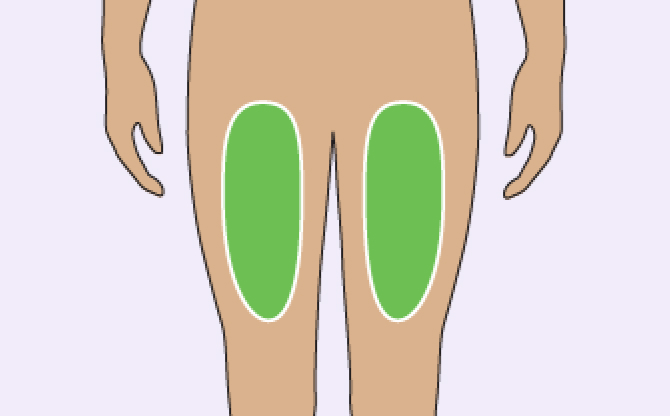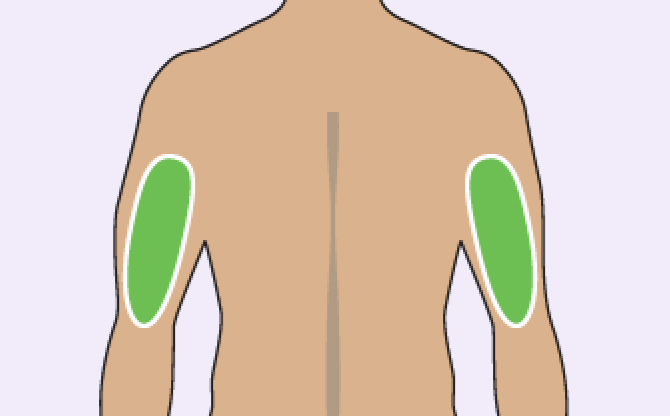TRYNGOLZA is a subcutaneous (under the skin) injection
you give yourself once a month via autoinjector


Stomach
Appropriate for self-injection

Front of the thigh
Appropriate for self-injection

Back of the upper arm
For healthcare providers or caregivers only to administer the injection

Not a real patient; actor portrayal.
With proper storage, TRYNGOLZA can be taken at home or while traveling
Additional instructions and information on storing and injecting TRYNGOLZA can be found in the Instructions for Use found inside the TRYNGOLZA packaging.
Not a real patient; actor portrayal.
If you miss a dose of TRYNGOLZA:
Take the missed dose as soon as possible
Inject TRYNGOLZA 1 month from the date of your last dose to get back on a monthly dosing schedule
Ask your healthcare provider if you have questions about your dosing schedule
How to self-administer TRYNGOLZA
Hi! I'm Michelle, a Patient Education Manager for Ionis. In this video, I'll be showing you how to self-inject TRYNGOLZA. You can contact your Patient Education Manager for more details of injecting TRYNGOLZA.
TRYNGOLZA comes in an autoinjector that you can use at home or on the go. You should do the injection in a place that you feel comfortable. If you prefer, it can also be administered by someone you trust.
Each TRYNGOLZA autoinjector has a single dose in it and can only be used 1 time. It should be injected on the same day of each month.
Let's take a closer look. This is the needle cap. It's on top of the needle shield that covers the needle. Here's the viewing window. You can see the plunger and the medicine through it.
Before you inject TRYNGOLZA, your healthcare provider should show you and/or someone you trust how to use it.
You should also be sure to read the complete instructions for use and patient information that are available on our website, TRYNGOLZA.com, and in your demo kit.
Now let's get into the steps for injection–prep, inject, and check. First, you'll want to prep your supplies.
You'll need the autoinjector, an alcohol wipe, and an FDA-cleared sharps container.
If you've been keeping your autoinjector in the refrigerator, make sure to let it come to room temperature for 30 minutes before you're ready to use it.
Once it's warmed to room temperature, take the autoinjector out of the carton. Make sure the needle cap is attached. Check the expiration date and look for any damage.
Check the medicine through the viewing window.
The medicine should be clear and colorless to yellow. Don't use the autoinjector if the medicine is cloudy, the wrong color, or if you see particles floating in it. It's normal to see air bubbles in the medicine.
Now pick where you want to inject. You can choose a spot on your abdomen or the front of your thigh. If you choose the back of your upper arm, someone will need to inject it there for you, since it's hard to reach.
Today, I'll be demonstrating how to inject into your thigh, but there are a few things to remember when picking an injection site.
If you inject on your abdomen, pick a spot at least 2 inches from your belly button.
It's important that you do not choose a spot that's bruised, tender, red, or hard. You also shouldn't inject into any scars or damaged skin.
After you've chosen the injection site, be sure to wash your hands with soap and water.
Use an alcohol wipe to clean the injection site, wiping in a circular motion like this. Then let the skin air dry.
Now we're ready to inject.
To take off the needle cap, hold the autoinjector by the middle with the needle cap facing away from you like this, and pull the cap straight off. Don't twist it.
The needle shield will be exposed. Don't touch it or push on it. The needle is under there.
Throw away the needle cap in the trash or sharps container.
Holding the autoinjector in 1 hand, place the needle shield at a 90-degree angle against your skin, making sure you can see the viewing window.
To inject, you'll firmly push and hold the autoinjector against your skin like this. You'll hear a click when the injection starts. You may hear a second click, but the injection is not finished.
Hold the autoinjector against your skin for 10 seconds to make sure that the full dose has been given. Do not move or reposition the autoinjector during the injection.
Now that we've held the autoinjector for 10 seconds while injecting, it's time to check that the plunger rod has moved down to fill the entire viewing window.
Now you can remove the autoinjector by lifting it straight up.
After you remove the autoinjector, the needle shield will lock into place and cover the needle.
Now that you've injected, do not recap the autoinjector or reuse it. Put the autoinjector in a sharps container right away. It should not be disposed of in your household trash or recycling.
And that's it! Please read or listen to the Important Safety Information next. Talk to your doctor if you have any questions and visit TRYNGOLZA.com to learn more. Thanks for watching.
INDICATION
TRYNGOLZA (olezarsen) is a prescription medicine used along with diet to reduce triglycerides (fat in the blood) in the treatment of adults with a condition that keeps the body from breaking down fats called familial chylomicronemia syndrome (FCS). It is not known if TRYNGOLZA is safe and effective in children.
IMPORTANT SAFETY INFORMATION
Do not use TRYNGOLZA if you have had a serious allergic reaction to TRYNGOLZA or any of the ingredients in TRYNGOLZA.
Before using TRYNGOLZA, tell your healthcare provider about all of your medical conditions, including if you: are pregnant or plan to become pregnant, and are breastfeeding or plan to breastfeed. It is not known if TRYNGOLZA can harm your unborn baby, or if it passes into your breast milk and if it can harm your baby.
Tell your healthcare provider about all the medicines you take, including prescription and over-the-counter medicines, vitamins, and herbal supplements.
What are the possible side effects of TRYNGOLZA?
TRYNGOLZA can cause side effects including allergic reactions that may be serious. Allergic reactions can include redness of the skin, red itchy bumps (hives), swelling of the face, chills or trouble breathing. Stop taking TRYNGOLZA and call your healthcare provider or get emergency help right away if you have any of these symptoms.
The most common side effects of TRYNGOLZA include injection site reactions (such as redness or pain at the injection site), decreased platelet count (blood cells that help to clot blood), and joint pain or stiffness.
These are not all the possible side effects of TRYNGOLZA. Tell your healthcare provider or treatment team about any side effect you may have.
You are encouraged to report negative side effects of prescription drugs to the FDA. Visit www.fda.gov/safety/medwatch, or call 1-800-FDA-1088.
Please see full Prescribing Information and Patient Information for TRYNGOLZA.
Important reminders about injecting
While injecting TRYNGOLZA with the single-dose autoinjector:
- Hold the autoinjector at the center at a 90-degree angle against your skin—there is no button on top
Make sure you can see the viewing window
Do not push the orange needle shield before placing against your skin
- Firmly press and hold the autoinjector in place for 10 seconds; a click will signal that the injection has started
You may hear a second click. This is normal—just remember to count to 10 to receive the full dose
Check that the orange plunger rod has moved down to fill the entire viewing window to ensure the full dose was delivered
- Do not move, turn, or change the angle of the autoinjector, but continue to press it firmly against the skin